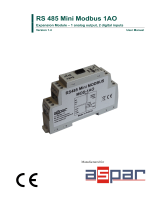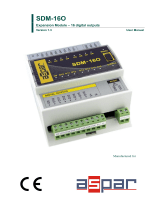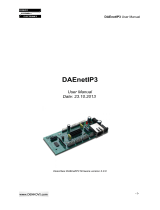
NOVUS AUTOMATION 2/38
1. SAFETY ALERTS ...............................................................................................................................................................................................4
2. PRESENTATION ................................................................................................................................................................................................5
3. IDENTIFICATION ...............................................................................................................................................................................................6
3.1 DEVICE IDENTIFICATION ..........................................................................................................................................................................6
3.2 DEVICE MODEL..........................................................................................................................................................................................6
3.2.1 RAMIX DO ETH / RAMIX RL ETH MODELS ....................................................................................................................................7
3.2.2 DMIX DO ETH / DMIX RL ETH MODELS .........................................................................................................................................7
4. INSTALLATION ..................................................................................................................................................................................................8
4.1 MECHANICAL INSTALLATION ..................................................................................................................................................................8
4.2 DIMENSION ................................................................................................................................................................................................8
4.3 INSTALLATION RECOMMENDATIONS .....................................................................................................................................................8
5. FEATURES AND CONNECTIONS ....................................................................................................................................................................9
5.1 POWER SUPPLY CONNECTIONS AND COMMUNICATION PORTS ......................................................................................................9
5.1.1 USB CONNECTION ..........................................................................................................................................................................9
5.1.2 RS485 CONNECTION ......................................................................................................................................................................9
5.1.3 ETHERNET CONNECTION ............................................................................................................................................................10
5.2 GALVANIC ISOLATION ............................................................................................................................................................................10
5.3 ANALOG INPUTS......................................................................................................................................................................................11
5.3.1 A1 – A2 STATUS LEDS ..................................................................................................................................................................11
5.3.2 ANALOG INPUT ERROR CONDITION ...........................................................................................................................................12
5.3.3 ANALOG INPUTS CONNECTION ..................................................................................................................................................12
5.4 DIGITAL INPUTS.......................................................................................................................................................................................13
5.4.1 D1 ... D8 STATUS LEDS .................................................................................................................................................................13
5.4.2 DIGITAL INPUTS CONNECTIONS .................................................................................................................................................13
5.5 ANALOG OUTPUTS..................................................................................................................................................................................14
5.5.1 O1 – O2 STATUS LEDS .................................................................................................................................................................14
5.5.2 ANALOG OUTPUTS CONNECTIONS ............................................................................................................................................14
5.6 DIGITAL OUTPUTS...................................................................................................................................................................................15
5.6.1 ACTION MODES .............................................................................................................................................................................15
5.6.2 POWER ON STATUS......................................................................................................................................................................16
5.6.3 SAFE STATUS WATCHDOG ..........................................................................................................................................................16
5.6.4 K1 ... K8 / R1 ... R4 STATUS LEDS ................................................................................................................................................16
5.6.5 DIGITAL TRANSISTOR OUTPUTS CONNECTIONS ....................................................................................................................16
5.6.6 DIGITAL RELAY OUTPUTS CONNECTIONS ................................................................................................................................16
5.7 LEDS .........................................................................................................................................................................................................17
5.7.1 OPERATION LED............................................................................................................................................................................17
5.7.2 RS485 COMMUNICATION LED .....................................................................................................................................................17
5.7.3 GENERAL STATUS LED ................................................................................................................................................................17
5.7.4 STATUS LED OF EACH CHANNEL ...............................................................................................................................................17
6. MODBUS PROTOCOL .....................................................................................................................................................................................18
6.1 COMMANDS .............................................................................................................................................................................................18
6.1.1 READ COILS – 0X01 ......................................................................................................................................................................18
6.1.2 READ DISCRETE INPUTS – 0X02 .................................................................................................................................................18
6.1.3 READ HOLDING REGISTERS – 0X03 ...........................................................................................................................................18
6.1.4 READ INPUT REGISTERS – 0X04 .................................................................................................................................................18
6.1.5 WRITE SINGLE COIL – 0X05 .........................................................................................................................................................19
6.1.6 WRITE SINGLE HOLDING REGISTER – 0X06..............................................................................................................................19
6.1.7 WRITE MULTIPLE HOLDING REGISTERS – 0X10 .......................................................................................................................19
6.1.8 MASK WRITE REGISTER – 0X16 ..................................................................................................................................................20
6.2 REGISTER TABLE ....................................................................................................................................................................................20
7. CONFIGURATION SOFTWARE ......................................................................................................................................................................27
7.1 NXPERIENCE ...........................................................................................................................................................................................27
7.2 CONFIGURING DIGIRAIL CONNECT WITH NXPERIENCE ...................................................................................................................27
7.2.1 GENERAL DEVICE INFORMATION ...............................................................................................................................................27
7.2.2 ANALOG INPUTS............................................................................................................................................................................28
7.2.3 DIGITAL INPUTS.............................................................................................................................................................................28
7.2.4 ANALOG OUTPUTS........................................................................................................................................................................29
7.2.5 DIGITAL OUTPUTS.........................................................................................................................................................................30
7.2.6 COMMUNICATION PARAMETERS ................................................................................................................................................31
7.3 DIAGNOSTICS ..........................................................................................................................................................................................33
7.3.1 FORCING DIGITAL INPUTS ...........................................................................................................................................................33
7.3.2 FORCING ANALOG INPUTS ..........................................................................................................................................................33
7.3.3 FORCING DIGITAL OUTPUTS .......................................................................................................................................................34
7.3.4 FORCING ANALOG OUTPUTS ......................................................................................................................................................34
























